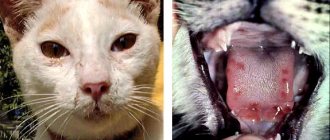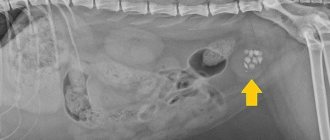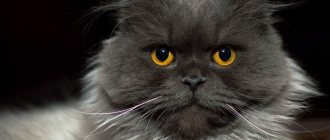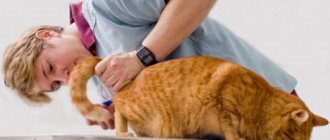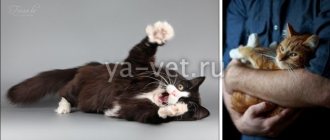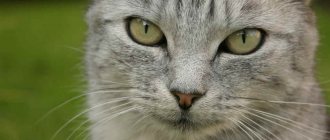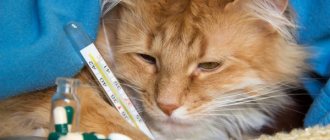INCREASE IN ABDOMINAL VOLUME can occur for a variety of reasons and over various periods of time - from several hours to several weeks.
In general, this condition can be observed for the following reasons:
- increase due to voluminous internal formations: pregnancy, (especially multiple pregnancy), large tumor, greatly enlarged uterine horns with its purulent inflammation - pyometra, significant accumulations of gas in the stomach and intestines, stagnation of feces, sharply enlarged bladder with acute urinary retention or atony. In some cases, large hernias can also simulate an enlarged abdomen.
- increase due to sagging of the abdominal wall: with endocrine diseases - for example, with hypothyroidism, Cushing's syndrome; Obesity manifests itself in a similar way.
– an increase due to the accumulation of fluid in the abdominal cavity (the nature of the fluid can be different - inflammatory and non-inflammatory (transudate, exudate, modified transudate). In this way, infectious peritonitis of cats, hemoabdomen (accumulation of blood in the abdominal cavity during bleeding), ascites in pathology can manifest liver (for example, cirrhosis), heart failure, neoplasms and other diseases.
Why does deviation occur?
The development of the deviation is influenced by pathological and physiological factors. The first are dangerous to health and require the intervention of a veterinarian. The latter are natural, so they are easy to figure out on your own.
Hazardous factors
The presence of pathology is indicated when the abdominal muscles do not relax for more than a day, and the pet’s condition gradually worsens. This is due to the following reasons:
Constipation
. It occurs due to intestinal spasms, improper feeding, ingestion of a foreign object, helminthiasis and the accumulation of hair in the intestines during heavy shedding. Without prompt treatment, constipation can lead to intestinal obstruction and death.
Peritonitis
. The peritoneal mucosa becomes inflamed upon contact with gastric or intestinal contents. The penetration of foreign microflora is fraught with epithelial detachment and necrosis.
Poisoning
. Against the background of acute intoxication, painful spasms occur in the lower part of the stomach.
Abscess
. The danger of purulent formation in the abdominal organs lies in its rupture and subsequent blood poisoning.
Injury
. When internal organs are damaged, their contents leak into the peritoneum. The further reaction is similar to peritonitis.
Cholecystitis (biliary colic)
. Inflammation of the gallbladder occurs when there is excessive production of bile or the formation of stones. The patient's peritoneum hardens and excruciating pain occurs.
Pyometra
. Purulent inflammation in the uterus appears with frequent mating, hormonal disorders and infections.
Ascites (abdominal dropsy)
. With this disease, free fluid accumulates in the abdominal cavity. Most often this occurs as a result of poor circulation.
Neoplasms
. The growth of the tumor is reflected in the size of the peritoneum. Most often, neoplasms occur in older animals.
Panleukopenia (distemper)
. Infection with the virus occurs in utero, during a bite by a blood-sucking insect, or through contact with an infected animal or its biological fluids.
All these causes can be eliminated with medication. Without timely help, even simple constipation becomes dangerous.
Non-hazardous factors
An enlarged and dense belly in a cat also appears for natural reasons. These include:
Flatulence
. A tight stomach appears when there is an excess accumulation of digestive gases. Usually this condition goes away with dietary adjustments, but sometimes it is a sign of helminthiasis, dysbacteriosis, intestinal obstruction and other diseases.
Pregnancy
. Shortly before childbirth, the size of the uterus increases greatly. The abdominal muscles become harder to protect the kittens inside the womb. The condition returns to normal a few hours after the birth of the offspring.
Stress
. By tensing the abdominal muscles, the pet tries to protect itself from the source of fear or unpleasant touches. This behavior is typical for animals that have suffered physical abuse.
Obesity
. If the pet is neutered and inactive, then it quickly gains weight. This situation can be easily managed with diet and increased activity. Remember that the lack of response threatens premature death from fatty degeneration of the myocardium, that is, obesity of the heart.
Associated symptoms will help distinguish pathological factors from physiological ones. If they are detected, you must immediately contact a veterinary clinic.
In what cases should you contact a veterinarian?
The most dangerous causes of an enlarged abdomen in a kitten are peritonitis and ascites. Without timely veterinary care, the pet may even die. How to recognize these dangerous pathologies:
- Peritonitis is an inflammation of the abdominal cavity of an animal. It is necessarily accompanied by the following symptoms: elevated body temperature;
- vomiting;
- refusal of food;
- weakness;
- apathy.
Peritonitis and ascites are life-threatening conditions, so you need to take the kitten to the vet as soon as possible. Only a specialist can treat these pathologies, and sometimes even minutes count.
Diagnosis and treatment
If there is severe bloating, give your pet activated charcoal. Up to 1 year, a quarter of a whole tablet is enough. At this point, self-medication will have to be postponed until examination at the clinic. Further therapy is selected individually and depends on the cause of flatulence.
At your appointment, describe your pet's diet to the veterinarian in detail. Along with the elimination of harmful foods, a detailed review of nutrition is possible. When overeating, fractional meals scheduled by the hour help. Use at least super-premium food, designed specifically for kittens, and follow the standards indicated on the packaging. If there is some food left in the feeder after a meal, remove it from a visible place and put it aside until the next feeding. Pets, like people, often eat out of boredom. Probiotics will help improve digestion.
Food allergies are treated in the simplest and most reliable way - eliminating the allergen. Kittens, unlike adult animals, have an extremely limited list of foods they can consume. Identify the “enemy” by elimination and remove it from your pet’s life forever.
If no errors are found in the diet or during examination, then all attention is concentrated on the examination of blood, urine and feces. The latest analysis is used to detect helminths
The condition of internal organs and the presence of tumors is diagnosed using ultrasound and x-rays.
For helminthiasis, anthelmintic drugs are prescribed to eliminate the causative agent of the disease. Until three months, the number of safe medications is limited, so choosing an anthelmintic on your own is unacceptable.
Detection of ascites or infectious peritonitis cannot be done without surgical intervention. After removing the accumulated fluid, the animal is placed in a hospital for observation. Antibiotics and anti-inflammatory drugs are used for recovery.
In the case of hepatitis, it is important to restore damaged liver cells. Hepatoprotectors cope with this task
The patient is also recommended drips with saline solutions, antibiotics and antispasmodics.
Treatment of pancreatitis is determined by the form, stage and neglect of the pathological process. For severe anorexia and complications, feeding tubes and blood transfusions are recommended. Dead pancreatic tissue is removed using laparoscopy.
Tumors in the gastrointestinal tract respond well to treatment only in a benign form. Malignant tumors are treated with surgery and chemotherapy. Unfortunately, the prognosis for animals with this diagnosis is very sad.
What are the signs of various skin lesions and how to treat them?
Dermatological diseases differ in clinical signs, which should be known to all owners of four-legged pets. Therapy is prescribed by the attending physician after diagnostic measures, determining the type of pathogenic microflora, parasites, or source of stress that has penetrated. The photo below shows a sick animal.
Allergic manifestations
Allergy refers to a non-standard reaction of the immune system to foreign substances that have entered the body. The culprit may be a new type of food, exposure to household chemicals, flowering plants and their pollen, synthetics, or house dust. Clinical signs of an allergic reaction: redness of the skin, areas of inflammation, severe itching, hair loss, fever. The cat is constantly itching - from the withers to the tail, all day.
Why does the cat have a fat belly?
Just like people, pets can have different body types and reasons that determine where fat deposits will accumulate - on the stomach in cats or in other parts of the body. As we have already said, some cats have a hanging belly, and some have a wider belly. This largely depends on the exterior and breed.
Body features are described by terms that characterize the types of constitution: loose (raw), rough, strong, dry. At the same time, for example, the raw type is characterized by more flabby muscles and a slower metabolism; in such a cat, belly fat will accumulate more under the skin and sag significantly. The rough type is characterized by thick skin and highly developed bones; such cats are more likely to be evenly rounded, including on the stomach.
Fat can accumulate in the subcutaneous tissue, then to the touch it seems that soft fluffy bags form in the animal’s lower abdomen, closer to the hips, where the skin fold is. Many owners are frightened by their appearance, but this is the most typical place for fat accumulation in cats.
Fatty tissue also accumulates in places where it cannot be seen—inside the body and on internal organs, including the kidneys and heart. A particularly large amount of fat accumulates on the omentum - connective tissue folds located in the abdomen near the intestines. It is because of the omentum that the belly of fat cats looks so round, tight and elastic, even if not much fatty tissue can be felt under the skin.
Clinical picture
The initial stage of the pathological condition is virtually asymptomatic, since the accumulation of fluid in the abdominal cavity is a gradual process. Characteristic signs can only be noticed when the volume of fluid significantly exceeds normal levels. Ascites can be suspected by a noticeably swollen abdomen and stretching of the sides when the animal is active.
Symptoms:
- the abdominal cavity is swollen, hard to the touch;
- fluctuation - when pressing on the abdomen, you can feel the liquid inside it swaying;
- the belly takes on the shape of a pear when the cat stands on its hind legs, and inflates and rounds when taking a sitting position;
- dullness and disheveled fur;
- yellowish tint of mucous membranes;
- paws, ears, crotch, sternum swell;
- vomiting, nausea;
- lack of appetite;
- constipation or diarrhea;
- breathing problems, hoarseness, shortness of breath;
- weakness, apathy.
It is very important to distinguish ascites from ordinary overeating.
What is a cat's fat tail?
A cat's fat tail is scientifically called a “primordial pouch,” which means a genetic tendency in some cat breeds to form a fold of skin on the abdomen, between the hind legs.
A small hanging tail is considered normal for cats if it is elastic, soft to the touch, does not cause pain and its size does not exceed 5 cm.
In felinology, there are several theories that explain this anatomical feature in cats:
- The inguinal skin fold is a “depot” for fat deposits, which are consumed during prolonged fasting of a cat, which allows animals to survive in the most difficult circumstances. Fat deposits in cats are especially noticeable during the winter cold.
- The fat tail acts as a repository of excess elastic skin, which is actively used when jumping high, long, while climbing trees or when entering narrow crevices, when the cat needs to stretch out “in line” to get to the desired place.
- A hanging belly in cats is an additional means of protecting internal organs during fights and fights with relatives. Cats tend to deliver powerful blows to the enemy with their hind legs, and an additional layer of skin will protect the vulnerable belly from damage to internal organs.
All domestic and wild cats have a fat tail, but in some it is more pronounced due to breed or physiological characteristics, in others it is less pronounced.
In spring and summer, the size of the saggy tummy in cats is significantly reduced, and in late autumn and winter the fat tail grows again.
Constipation
If everywhere is clean, but the cat's tray is still empty, you should pay attention to the behavior and general condition of the pet. Constipation in cats after surgery can be very painful. The cat takes a pose characteristic of symptoms of constipation: the animal screams pitifully, the tail trembles. If you experience constipation after surgery, you should not use any laxatives without consulting a doctor. You can help with constipation by giving your animal one tablespoon of Vaseline oil.
It is perfectly absorbed by the body and does not harm the general condition of the animal at all. For constipation after surgery, this drug can be given three times a day. You need to take a syringe without a needle and inject the mixture into the cat’s cheek. If constipation does not go away after 24 hours, be sure to call the veterinarian. An experienced specialist, after an examination and x-ray, ultrasound, will be able to tell you how to cure constipation in a cat after sterilization.
Sometimes a regular enema can help a cat much more than a laxative for constipation. However, such manipulations must be done by a doctor. In most cases, constipation after sterilization can be eliminated by creating a special diet and prescribing softening medications.
Signs of an enlarged abdomen in cats
A kitten may overeat and after eating a portion of tasty food, his stomach feels like his stomach is about to burst. Or he ate very little, and his tummy is swollen.
A kitten's bloated belly can be accompanied by the following symptoms:
- Vomit. When overeating, as well as in order to free the digestive tract from foreign objects, it is usually one-time use.
- Diarrhea. Often in young animals it appears as a result of incorrectly chosen food. Diarrhea is a dangerous symptom, as it may indicate a parasitic infection.
- The appearance of dead helminths in the feces indicates a massive parasitic infection. This condition is also dangerous, since parasites poison the body with waste products.
- Perversion in appetite indicates the desire of kittens to eat inedible or difficult to digest foods. This phenomenon often indicates that the animal lacks vitamins and microelements.
- Inflammatory processes in the oral cavity indicate irritation of the digestive tract. As a result of irritating chemicals entering the stomach, the tummy becomes enlarged and causes severe pain.
- Flatulence is observed very often in kittens. The kitten's intestines are swollen. The kitten is often restless, he runs and rushes about.
Causes of the disease
Ascites has its own reasons , or rather, there may be several of them:
- diseases of the cardiovascular system, in which the normal movement of blood through the vessels is disrupted and it stagnates in the veins of the abdominal cavity;
- liver diseases (hepatitis, cirrhosis), which cause stagnation of blood in the portal veins of the liver (cava and portal veins);
- kidney diseases accompanied by insufficient fluid excretion and retention in the body;
- benign and malignant tumors;
- metabolic disorders in the cat’s body (water, protein, vitamin).
When does sagging indicate internal changes?
Establishing the real clinical picture is the prerogative of the veterinarian. The breeder can only identify the initial signs if it seems to him that the cause of sagging skin is a disease.
Dangerous symptoms
Pathological problems are caused by certain symptoms. Sagging fat alone is not enough to cause panic. So, if a cat has loose skin on its belly and there are a number of other symptoms, there is a good reason to visit a doctor:
- The pet's belly increases in size over time.
- Swelling forms around the abdominal cavity. Usually the lower abdomen increases in size.
- When palpated, the cat experiences pain. She will avoid touching the area of the body that causes discomfort.
- The coat color changes noticeably in the place where the pathology is visually detected.
In addition to the above signs, there are also the following:
- the animal loses its appetite;
- body weight decreases rapidly;
- the cat becomes apathetic and avoids communicating with people;
- the pet stops playing and running. Sleeps more.
All these signs clearly indicate one of the conditions: constipation, intestinal obstruction, helminthic infestations, renal failure. There are probably other disorders in the body.
Pregnancy
In some situations, unexpected news for the owners comes to light - the cat is waiting for an addition. It is not difficult to guess about such a “surprise” on your own - the belly feels quite dense to the touch, and the mammary glands increase in size (swell) closer to the birth process.
Oncology
True, a tight tummy, the size of which increases, can also be the result of tumor growth in the abdominal cavity. Then you should take the nipples as a distinctive feature - they will remain normal.
Symptoms of ascites
The first and most obvious signs of ascites are the following symptoms:
- swollen, tight stomach (“bulging” sides);
- poor appetite (sometimes complete refusal to eat);
- flatulence, constipation, diarrhea;
- vomiting (most often with saliva);
- depressed mood (anxiety, sadness, apathy, etc.) due to abdominal pain;
- heavy breathing (rapid breathing, with wheezing, groaning, coughing, etc.);
- the cat tries to lie on its side;
- caution in movements (slow gait, uncertain steps, etc.);
- refusal to play and fatigue;
- weakness (fainting is also possible).
Some owners may mistake dropsy for the first signs of pregnancy (in cats), helminthic infestation, or flatulence. To make sure that it is definitely not gases or a fetus, it is enough to take the sick cat in your arms. In an animal in an upright position, the fluid will flow into the lower abdomen. As soon as you place the cat on the floor, the water will again be distributed throughout the abdomen.
Photo gallery: some signs of ascites in cats
With ascites, the cat's stomach "swells" A sick cat may become apathetic or aggressive If ascites, a cat may have diarrhea or, conversely, constipation Cats with dropsy do not eat well, sometimes completely refuse to eat A sick cat may cough or have difficulty breathing
It is important to recognize dropsy immediately and contact a veterinarian, because time may not be in your favor. For example, in cats with diabetes, the volume of fluid can reach 2-3 liters (the larger the cat, the more fluid) in just 2-3 days.
Breed characteristics
Some breeds have a fold in the abdominal area their entire life. And, by the way, there is nothing reprehensible in this, since natural affiliation simply obliges you to “possess” a fat tail.
Do not be upset if the skin hangs on the belly of a cat of the following breeds: Canadian Sphynx, Pixie-Bob, Bengal, Scottish Straight, Scottish Shorthair. The reasons for the presence of loose skin in pets of these breeds are unknown. Probably, the fat layer should protect short-haired and hairless individuals from the cold, and for others, the fat tail should protect the abdominal organs from injury during fights.
Important! You should not try to reduce a saggy belly by starving your pet. With such a diet, the skin will not go anywhere, but, on the contrary, will become even more noticeable on a body that is too thin
In those cats that, by their breed vocation, are forced to “wear” a fat tail, the stomach decreases during the lactation period. As soon as the feeding of the kittens stops, the size of the saggy tummy returns to normal.
Feeding cheap foods
Veterinarians strongly recommend analyzing your pet’s diet. After all, unhealthy food from economy class (Whiskas, Felix, Kitekat) will sooner or later cause disruption of the digestive tract. Along with the indicated nutrition, the foods that people love to feast on are harmful. Sausages, dairy products, soups and main courses from the human table are not suitable for consumption by animals. Pathologies of the gastrointestinal tract can easily lead to the death of a cat. High-quality industrial food that will not harm your pet - Akana, Hills, Perfect Fit, Purina Van and other branded products from the premium, superpremium segment. If the owner’s choice is made in favor of natural nutrition, then among the healthy foods for the mustachioed pet can be noted: cereals (rice and oatmeal), meat (beef, turkey, rabbit), stewed vegetables (carrots, cabbage, beets). It is necessary to remember the basic rule: mixing natural food and ready-made food is prohibited.
If your cat has sagging skin on its belly despite a well-thought-out diet, then you should slightly reconsider its diet.
It is important to reduce the calorie content of dishes by reducing the amount of meat component to 50-70%
Diagnostics and therapy
To make a diagnosis, blood, urine and feces are examined, ultrasound and x-rays are done. During the examination, the veterinarian palpates and listens to the peritoneum. Depending on the results that explain why the cat has a hard stomach, the doctor decides what to do to normalize his condition.
Help with non-dangerous causes of bloating
Flatulence caused by poor nutrition can be eliminated by adjusting the diet. A ban is imposed on any products that increase gas formation (legumes, flour, fresh vegetables). Remember that milk is contraindicated for adult animals, as they develop lactose intolerance. To normalize intestinal function, your veterinarian may recommend a course of probiotics.
Excessive weight can be eliminated by reviewing your diet. The animal is prescribed less high-calorie food and the usual portions are reduced. Daily physical activity is complemented by joint games.
A big belly in a scared cat can be healed with time. Do not impose your affection and let your pet get used to the unfamiliar environment.

